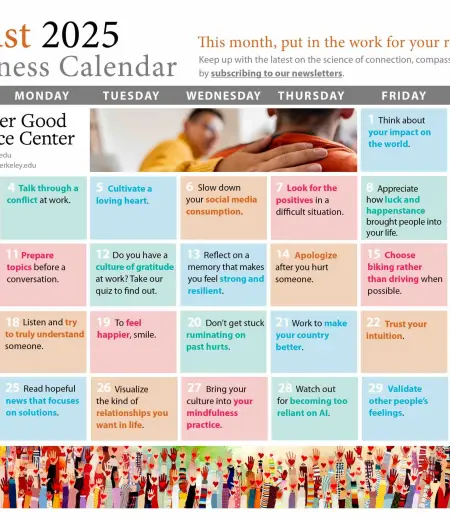Employees who usually get along well are blowing up at each other. Managers are reporting that employees are having emotional outbursts in meetings and they’re not sure how to respond.
That was the start of my call with a chief human resources officer (CHRO) at a reputable nonprofit recently. They reached out looking for resources to support what seemed like a rapidly declining workplace culture. Teams weren’t working together as well as they used to, employees weren’t performing at their usual level, and managers were at a loss about what to do. Something was off.
I reminded the CHRO that they’ve been here before. The culprit? Uncertainty.
X

When there’s uncertainty, distress tends to follow. Our brains are hardwired for certainty. Evolutionarily speaking, predictability was what kept us alive, and our amygdala can perceive uncertainty as a threat, which kicks off the stress response. That was what the CHRO was describing to me.
This nonprofit’s experience is not unique. In my work as an employee well-being consultant at Yes Wellbeing Works, I field numerous calls, emails, and inquiries like this, especially during times of heightened uncertainty. A few years ago, it was the pandemic. At other times, it’s been related to financial crises within organizations. More recently, it’s been the shifting political climate, resulting in unpredictability, financial uncertainty, job loss, and anti-immigration rhetoric. These forces don’t just affect businesses—they’re potentially felt by employees on professional and personal levels.
If you’re a manager or organizational leader, you may be feeling similar to this CHRO. You might not be really sure what to do or what is within your locus of control. And while, yes, much of what is happening now may not be fully within your control, from our work and research at Yes Wellbeing Works, we know that the relationship employees have with their manager is one of the strongest factors affecting their overall well-being in the workplace.
That’s why I’m pulling from my seven years of consulting and training to offer some guidance on how to respond to employee distress related to uncertainty—both reactively, in the moment, and proactively, over the long run.
What is employee distress?
What do I mean when I say “distress”? I’m talking about responses in our body and mind to experiences of chronic stress. Because the neurological stress response fills our body with hormones, impacting not only our brain but other biological functions, its presence can materialize in both physical and psychological ways.
External signs might include lethargy, lack of focus, withdrawal, irritability, jitteriness, problems remembering, frequent self-criticism, avoidance, impatience, indecisiveness, and more. If you as a manager are seeing these kinds of shifts in normal behavior, that may be an indication of distress.
Yes, employee mental distress can hurt performance. It’s true, there’s no denying it—and it’s not too much different from physical distress (e.g., a cold, broken leg, stomachache, etc.), which can of course also influence performance.
The challenge, especially in high-performance workplace cultures, is that managers tend to only see the performance implications of the distress and attempt to resolve it with traditional performance management tools: disciplinary action, rewards and recognition, and sometimes even separation. Unfortunately, none of that addresses the root cause of the problem in situations of uncertainty.
That’s why, when presented with potential signs of distress, you have to be willing to ask: “Could there be something else going on?” Asking that question invites a pause and allows you to choose a different course of action other than performance management. Instead, you’re employing a Mental health perspective. To be clear, the goal of both perspectives is the same: to get the employee back on track. The process is just different, and it’s a question of choosing the right tools.
Tools for reactive responding
What might this look like in practice, in the face of an immediate challenge?
Let’s say you have an employee, Elizabeth, who you’ve worked with for the past three years. Federal funding cuts have hit your organization hard, but so far communication to employees about how that will affect them and their work has been sparse. You also know that Elizabeth’s partner is a federal employee.
Typically, Elizabeth does great work: proactively collaborates with colleagues, takes the lead on key projects, and for the past year has been the chairperson of the organization’s social committee, planning after-work activities for employees.
But over the past week, Elizabeth has been logging on late to meetings, and when she does arrive, she frequently yawns throughout the meeting (lethargy). She’s missing deadlines (trouble focusing, problems remembering), and she didn’t show up to the last social event she planned (lack of motivation, withdrawal). During a meeting, a colleague questioned her about a report that she hadn’t turned in yet, and she snapped at them (irritability).
Clearly, there’s been a shift in Elizabeth’s behavior. So, what should you do? Here are a few immediate steps to consider taking:
1. Check in with yourself. While the focus of this article is about providing support to employees, I want to recognize the emotional needs of managers, as well. Prior to offering support, check in with yourself, assess if you have the psycho-emotional bandwidth to offer support to your employee. Here’s a one-minute video I did during the pandemic walking you through a brief checking-in exercise:
If you don’t have it in you, it’s OK; identify another resource in the organization who can carry forward the below steps (e.g., HR, a dotted line manager, team lead, etc.).
2. Initiate a conversation of support while reducing reputational risks. Contrary to traditional performance management tools, often rooted in discipline, starting with support is a potentially more helpful alternative, in this case. If you notice signs of distress in employees, you want to initiate a conversation of support while at the same time reducing reputational risks for them.
One of the main reasons employees do not talk about Mental health challenges in the workplace is stigma and the erroneous association between mental distress and incompetence. Nobody wants to be perceived as though they can’t do their job, so making sure you address perceptions about reputational risks is important.
You first want to make sure the employee has the bandwidth for the conversation, so I suggest setting up some time on their calendar for a one-on-one; if you’re in the office together, going for coffee can be a nice alternative. Once in the allotted time for the conversation, your opener should have three parts: the objective facts, plus reduction of reputational risks, plus statement of concern. So you might say something like this:
Elizabeth, I noticed a shift in how you’re showing up in the workplace lately, you missed a few deadlines, you seem more tired—and yesterday you snapped at Paul in the meeting. I know this is not like you, and I want to check in.
3. Create space for the employee to respond. Once you finish your conversation opener, now it’s time to pause and listen. When listening, you are doing so for several reasons: to see if the employee is willing to engage with you, to potentially understand the root cause of the observed behavior, and as a form of support.
During times of uncertainty, listening to better understand the root cause of the observed behavior can not only help you to support Elizabeth, but also to aggregate sentiments you’re hearing across your employees, as a potential indicator that a broader sweeping form of support may be necessary (more on that below, under tools for responding proactively). Listening can also serve as a form of support by reducing feelings of isolation and demonstrating care through active listening.
Please note that it’s not uncommon for employees to refuse to engage, for various reasons. Your goal is not to force them to open up to you, but to express your support of them and give them the opportunity to discuss what’s going on if they choose to do so. If they do refuse to engage this time, you can always try to initiate a conversation in the future if the signs of distress persist.
4. Offer active support. Let’s say Elizabeth is open to engaging with you, and she says something like this: “I’ve been feeling really nervous about the fate of our organization. I can’t stop worrying about my job security. Also my family has been really impacted by all of the uncertainty. It’s been a really stressful time for me lately.”
In this situation, empathic support is great; you can and should say: “I’m sorry to hear that.” However, while you may not be able to solve the uncertainty problem, as a manager you are uniquely positioned to offer real, tangible support that could have a meaningful impact on reducing the employee’s current stress load.
An often-overlooked form of active support that also allows the employee to maintain their agency is to first ask, “How can I best support you during this period?” Oftentimes employees know what might make a difference to help them through a challenging time.
A few other forms of active support include:
- Reprioritizing their workload: removing deliverables that are neither urgent nor important.
- Providing resources: allocating additional human, monetary, or tool-based resources to complete a project.
- Compensatory time off: most full-time–exempt employees work more than 40 hours a week. Some organizational structures have norms that allow for occasionally providing employees with compensatory time off.
- Sharing resources: sharing your organization’s behavioral health resources (e.g., Employee Assistance Program, Headspace Mental health app, Calm app, etc.) or other resources you know of that can be helpful.
It’s important to note that if ever during the conversation you become uncomfortable or hear something that goes beyond simple distress toward, for example, suicidal feelings, then you should consider escalating to your Human Resources professional, especially if it’s a matter of safety for the employee or others.
Tools for responding proactively
You don’t have to wait until you see signs of employee distress to offer support. Times of uncertainty are great opportunities for managers to practice proactive management skills that can limit distress. By acknowledging that uncertainty can lead to distress, you can try to manage in a way that reduces uncertainty:
1. Over-communicate. Keep communication with your employees frequent and fact-based. Even if there is nothing new to report, you can share that “I don’t have an update on XYZ.” Why? Because in an absence of information, employees may create their own narratives about what’s going on, and typically their narrative is far more sensational or catastrophizing than the reality. Get in front of that with regular communication and information-sharing. Think: snackable bits of information at regular intervals.
2. Address common shared experiences. This brings us back to listening to Elizabeth above. Hopefully, as a manager, you’re having regular engagement with all of your employees. During times of uncertainty, you want to listen for patterns of shared experiences that paint the truth of the current workplace dynamic and its impact on employees. When you hear that, call an all-hands for your team and acknowledge it. And if you’re willing to be vulnerable, share how the current climate is impacting you. This kind of step helps employees to not feel so isolated, and it communicates, “It’s OK to be honest about our experiences.”
3. Strengthen psychological safety. At Yes Wellbeing Works, we define psychological safety as “the capacity to show up authentically, make mistakes, push back, and seek support without fear of negative consequences.” When psychological safety is high on teams, honesty, help-seeking, and positive group dynamics tend to be higher, too, all of which can buffer employees from distress as they navigate uncertainty.
4. Build Self-awareness and self-management. These are foundational Emotional intelligence skills. Managers can and do also experience distress. A great way to support your employees during times of uncertainty is to take care of yourself. Specifically by being aware when you may be experiencing distress and then self-managing by seeking support or taking a break, perhaps turning to your own boss. Doing so can model vulnerability and reduce the likelihood that your distress is directed toward employees.
Uncertainty can lead to employee distress, but with the right tools it doesn’t have to. And while managers may not be able to resolve the uncertainty, it will only exacerbate the situation in the absence of support, communication, psychological safety, and Self-awareness.













